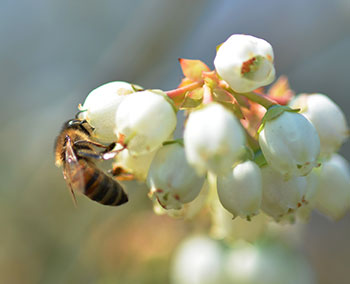Bacterial Disease of Bees Subject of Multi-State Study
A study into European foulbrood disease funded by the Oregon Blueberry Commission in 2022 has turned into a multi-state federally funded project seeking to root out factors contributing to increased incidence of the disease in honeybee colonies.
At the OSU Blueberry Field Day on July 23, OSU Extension apiculturist Ramesh Sagili, said researchers in four states – California, Washington, Mississippi and Oregon – are involved in the research.
 |
The work started in Oregon under funding from the commission as OSU researchers sought answers to why European foulbrood disease has become more prevalent in recent years, Sagili said.
“Usually we would see this in the spring and then the disease would go away,” he said. “But for the last six or seven years, we have seen this disease persist until August or September.”
The bacterial brood disease also has appeared to worsen when beekeepers move hives into blueberries, Sagili said, and some beekeepers blame blueberries for contributing to the disease, an assessment Sagili disagrees with.
“I don’t think blueberries are causing the disease,” he said. “It’s just the environmental factors and other factors that we think are making a perfect storm when they are in blueberries.”
European foulbrood disease can be problematic not just for beekeepers, but also for growers, Sagili said, as colonies that are infected with European foulbrood disease lose vigor to the point they can lose effectiveness as pollinators.
“It’s not just a problem for the beekeeper,” Sagili said to blueberry growers at the field day. “It might be a problem for you, as well, because the colonies may not provide good pollination.”
““It’s not just a problem for the beekeeper. It might be a problem for you, as well, because the colonies may not provide good pollination."
|
OSU researchers gathered some preliminary data in their initial study into the disease, and subsequently used that data to apply for a USDA Specialty Crop Research Initiative grant, which was awarded to a team of researchers from the four states last year.
The current project involves looking at the issue from several angles, Sagili said, including whether a lack of nutrition is contributing to the problem; whether colonies already have the disease when they leave almonds or only contract it once they hit blueberries; whether the disease has mutated and a new variant is now contributing to the higher rate of infection in colonies than previous rates; and other angles.
“We are trying to tease apart these different factors,” Sagili said.
The research involves analyzing colonies as they come out of four different crops, including almonds and blueberries, to see if the disease incidence increased dramatically while in any specific crop. Researchers also are analyzing colonies at four different times of year to try and pinpoint when the disease first strikes colonies. Researchers also are collecting pollen from crops to see if bees are being exposed to pesticides and if that is a contributing factor. They are analyzing the nutritional status of pollen to see if bees are suffering from a lack of nutrition in certain crops. And researchers are analyzing the bacteria causing the disease to see if there have been mutations.
“We are looking at typical and atypical variants,” Sagili said.
First-year data from the four-year project is showing that approximately ten percent of the hives coming out of almonds are testing positive for the disease. After blueberries, disease incidence rises to approximately fifty percent. The research has yet to uncover why that is occurring.
Researchers also hope to develop strategies to mitigate issues with European foulbrood disease.